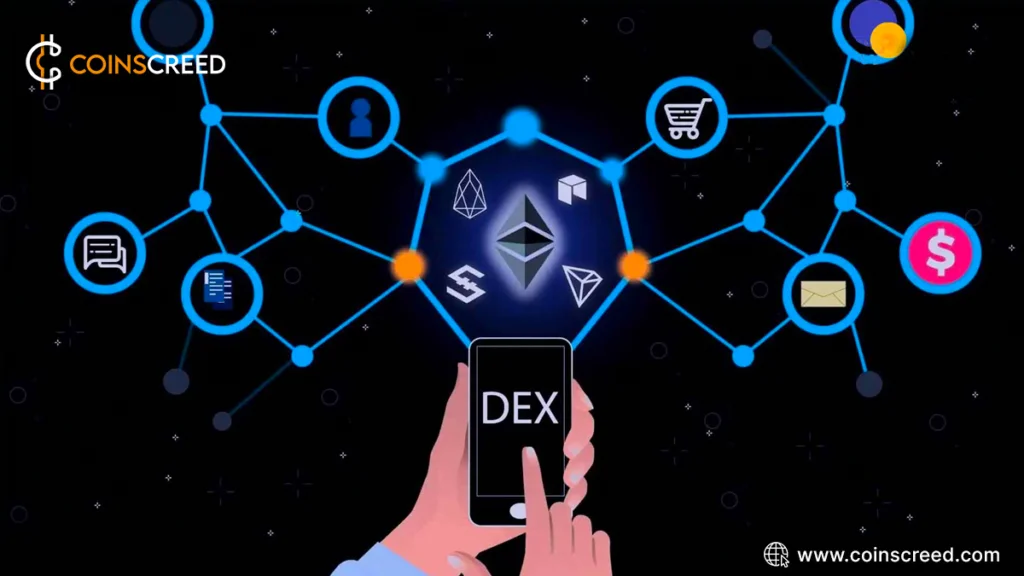Decentralized Applications, or DApps for short, are a relatively new phenomenon rapidly gaining traction in blockchain and cryptocurrency. These apps are built on decentralized networks, meaning any single entity or organisation does not control them. This article will discuss everything you need to know about Decentralized Applications (DApps) as a beginner.

What are DApps?
Decentralized applications, or DApps, are software programs that run on a blockchain or peer-to-peer (P2P) network of computers instead of on a single computer. Decentralised applications run on a blockchain network.
Unlike traditional applications, which are controlled by a central entity, DApps are distributed across a network of computers. This makes them more secure and resistant to hacking and censorship.
DApps are built using smart contracts, which are self-executing contracts that automatically enforce the terms of an agreement. Smart contracts are programmed to perform specific functions, such as transferring funds or verifying identity.
How do DApps work?
DApps are built on blockchain networks, decentralized ledgers that record transactions. These networks are maintained by a group of users, who use their computing power to validate transactions and maintain the integrity of the network.
When you use a DApp, your transactions are recorded on the blockchain network. These transactions are verified by other users on the network, ensuring that they are valid and secure.
How to use DApps?
Using DApps can be intimidating for beginners, but it’s pretty simple. Here are the steps to follow:
- Choose a DApp
- Create a Wallet
- Fund your Wallet
- Connect to the DApp
- Use the DApp
> Choose a DApp
There are many types of DApps, each with unique features and functions. Some popular DApps include decentralised exchanges, social networks, and gaming platforms. Choose a DApp that interests you and suits your needs.
> Create a Wallet
Before you can use a DApp, you need to create a wallet. A wallet is a digital account that allows you to store and manage cryptocurrency. Many wallets exist, including hardware, desktop, and mobile wallets. Choose a wallet compatible with the blockchain network on which the DApp is built.
> Fund your Wallet
Once you have created a wallet, you must fund it with cryptocurrency. You can purchase cryptocurrency on a crypto exchange or receive it from someone else. Ensure you have enough cryptocurrency in your wallet to use the DApp.
> Connect to the DApp
To use the DApp, you need to connect your wallet to the network on which the DApp is built. This is usually done by clicking a “connect wallet” button on the DApp’s website or app. Once you have connected your wallet, you can access the DApp’s features.
> Use the DApp
Once you have connected your wallet, you can start using the DApp. This may involve buying and selling cryptocurrency, participating in social networks, or playing games. Ensure you understand the DApp’s features and functions before using it.

Pros and Cons of Using DApps
Pros
- The lack of third-party and smart contract technology reduces costs and increases transaction speed.
- Decentralised platforms are invulnerable to attacks and offer high levels of security.
- DApps can be applied to a wide range of industries, making them versatile
- Users retain control over their data and can choose who sees it and for how long
- DApps offer a future free of corporate control and can potentially benefit users financially
Cons
- Lack of central authority can lead to slower updates and platform changes
- DApps require a reasonably-sized user base to operate properly
- Accessing DApps can be difficult for non-tech-savvy users
- Blockchain networks are currently limited in their capacity to handle large volumes of transactions, leading to scalability issues
- Lack of regulation in the DApp space can make it difficult for users to determine the legitimacy and safety of a DApp before using it
Things to note when using DApps
- Use a reputable DApp
- Be aware of fees associated with using a DApp
- Be mindful of your security when using DApps
> Use a reputable DApp.
Make sure that you are using a reputable DApp. There are many scam DApps out there that are designed to steal your cryptocurrency. Before using a DApp, research and ensure it has a good reputation in the blockchain community.
> Be aware of fees associated with using a DApp.
Second, be aware of the fees associated with using a DApp. Because DApps are built on blockchain networks, they typically involve transaction fees. These fees can vary depending on the network and the type of transaction you are performing. Ensure you understand the fees associated with using a DApp before using it.
> Be mindful of your security when using DApps
Finally, be mindful of your security when using DApps. Because DApps involve the use of cryptocurrency, they can be a target for hackers. Use a secure wallet and follow best practices for keeping your cryptocurrency safe.
Conclusion
DApps offer numerous benefits over centralized applications. From reduced costs and faster transaction speeds to increased security and user control over data, there are many reasons to start using DApps today. Although there are some cons to consider, such as slower updates and platform changes, limited scalability, and difficulty in accessing DApps for non-tech-savvy users, the potential benefits outweigh these concerns.
Using DApps is a great way to take advantage of the security and decentralization of blockchain networks. Following the steps outlined in this article and keeping the above tips in mind, you can confidently start using DApps. Remember to research, be mindful of fees and security, and enjoy the exciting new world of decentralized applications.
